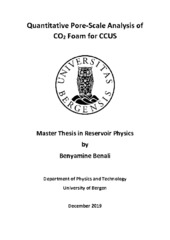Quantitative Pore-Scale Analysis of CO2 Foam for CCUS
Master thesis
Permanent lenke
https://hdl.handle.net/1956/21300Utgivelsesdato
2019-12Metadata
Vis full innførselSamlinger
Sammendrag
This experimental thesis is a part of ongoing projects lead by the Reservoir Physics group at the Department of Physics and Technology, University of Bergen. The main objectives of this thesis were to develop image analysis software to quantitatively describe CO2 foam for CCUS at the pore scale, investigate the separate and combined use of surfactants and nanoparticles as foaming agents for CO2 foam in the absence of oil at pore space, and to study calcite precipitation and dissolution in a micromodel to shed light on pore scale mechanisms during CO2 storage in carbonate reservoirs. The high pressure silicon wafer micromodels used enabled direct pore-scale visualization at relevant pore pressures of fluid dynamics, foam texture, foam stability, and foam performance. Micromodel porosity and permeability were found to be 0.607 ± 0.001 and 2.97 ± 0.07 D, respectively. Qualitative image analysis of fluid displacements occurring in the micromodel is useful to shed light on potential new displacement mechanisms, but provide limited information in a restricted field of view and it is time consuming. A major contribution in this thesis is the development of new image analysis tools that allow quantitative analysis on fluid displacement mechanisms and CO2 foam behavior. Access to dynamic, quantitative data from image analysis enables calculation of bubble generation and coalescence rates during CO2 injections, and direct comparison when parameters are varied in a controlled manner. The software development and experiments reported has been conducted in collaboration with PhD candidate Tore L. Føyen. The CO2 was injected in an unsteady-state approach, where the pores were initially fully saturated with fluid (brine and surfactants and/or nanoparticles) before the CO2 was injected at constant rate (1 μl/min or 4 μl/min). The microscope continuously captured images of the pore scale displacement during injection, and the images were analyzed by the developed software. The number of bubbles was obtained from each image and plotted as a function of the pore volumes CO2 injected. In addition density plots were used to illustrate the location of the bubbles and visualize the channels and foam generation path. Results from the CO2 foam experiments show that surfactant and nanoparticles generated a strong foam compared to baseline: bubbles numbers recorded when using foaming agents (surfactants and nanoparticles) increased significantly relative to the baseline (no foaming agent present, only brine), indicating a high CO2 mobility reduction. The number of bubbles increase with increasing surfactant concentration (0.05 wt% to 0.5 wt%), and the foam was found “shear thickening” for increasing rate. The comparison made between surfactant- and nanoparticle-stabilized foams at pore-scale indicates that surfactants have a higher ability to generate foams, whereas nanoparticles display a more significant potential to stabilize foams. The synergy between nanoparticles and surfactant demonstrated that foam generation and stability are independent of nanoparticles concentration in the absence of oil for the concentrations used in this thesis. The reported laboratory pore scale observations of calcite precipitation and dissolution were conducted in collaboration with PhD candidates Malin Haugen and Tore L. Føyen. A procedure for using of Sporosarcina pasteurii bacteria was developed as part of this thesis, and the calcite successfully precipitated in the pore space and calcite dissolution was studied at room temperature using 2 wt% hydrochloric acid. The procedure must be further developed to achieve a uniform distribution of calcite in the pore space to allow for controlled experiments related to the dissolution of calcite during CO2 storage in carbonate.
